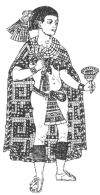
Sacred Texts Native American Maya Index Previous Next
Buy this Book at Amazon.com

Yucatan Before and After the Conquest, by Diego de Landa, tr. William Gates, [1937], at sacred-texts.com
In building their houses their method was to cover them with an excellent thatch they have in abundance. or with the leaves of a palm well adapted to that purpose, the roof being very steep to prevent its raining through. They then run a wall lengthways of the whole house, leaving certain doorways into the half which they call the back of the house, where they have their beds. The other half they whiten with a very fine whitewash, and the chiefs also have beautiful frescos there.
 Click to enlarge |
The common people build the chiefs’ dwellings at their own expense. The houses having no doors, it is held a grave offense to do any wrong to another's house; in the back, however, they have a small door for household uses. They sleep on beds made of small rods, covered with mats, and with their mantles of cotton as covering. In the summer they sleep in the front part of the house on the mats, especially the men. Away from the house the entire village sows the fields of the chief, cares for them, and harvests what is required for him and his household; and whenever they hunt and fish, or at the salt gathering time, they always give a part to the chief; in these matters everything is always in common.
If the chief should die his eldest son would succeed him, but the others would always be much respected, favored and held as lords. The leading men, lower than the chief, are favored in all these matters according to who they are, or the favor shown them by the chief. The priests live upon their benefices and offerings. The chiefs govern the town, settling suits, ordering and adjusting the affairs of the commonwealths, doing all through the hands of the leading men. These latter are much honored and obeyed, especially the wealthy, the chiefs visiting them and holding court at their houses for the settlement of affairs and business, this being done principally at night.
[paragraph continues] Whenever the chiefs leave the town they have a great company in attendance, and the same when they leave their houses.
The Indians of Yucatan are people of good physique, tall, robust and of great strength, and commonly are all bow-legged from having in their infancy been carried astride the mother's hip when they are taken somewhere. It was held as a grace to be cross-eyed, and this was artificially brought about by the mothers, who in infancy suspended a small plaster from the hair down between the eyebrows and reaching the eyes; this constantly binding, they finally became cross-eyed. They also had their heads and foreheads flattened from infancy by their mothers. Their ears were pierced for earrings and much scarified from the sacrifices. They did not grow beards and say that their mothers were used to burn their faces with hot cloths to prevent the growth. Nowaday beards are grown, although they are very rough, like hogs’ bristles.
 Click to enlarge |
Their clothing was a strip of cloth a hand broad that served for breeches and leggings, and which they wrapped several times about the waist, leaving one end hang in front and one behind. These ends were embroidered by their wives with much care and with featherwork. They wore large square mantles, which they threw over the shoulders. They wore sandals of hemp or deerskin tanned dry, and then no other garments. *
33:* The foregoing portrait of Nezahualpilli, king of Tezcoco, attributed to Ixtlilxochitl, although Mexican, illustrates well the garments here described.